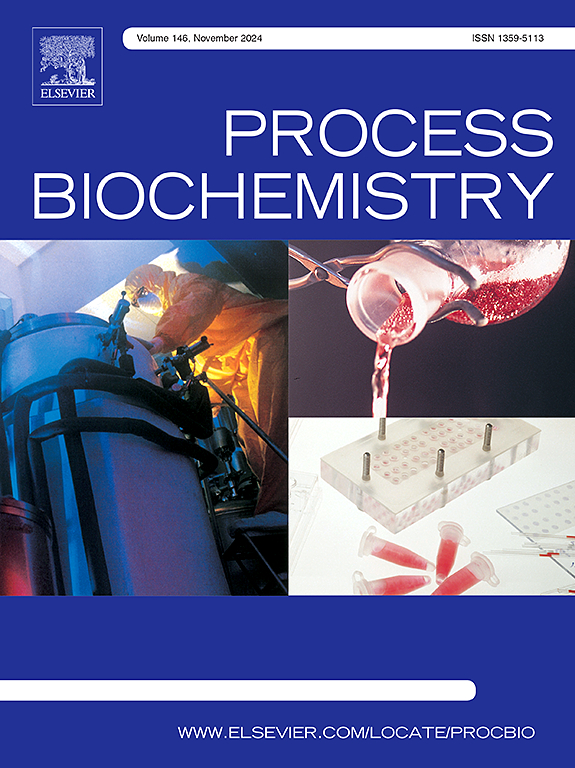(S)-布洛芬酰胺在黑腹果蝇中的混酶合成及其对衰老和胃保护作用的评价
IF 4
3区 生物学
Q2 BIOCHEMISTRY & MOLECULAR BIOLOGY
引用次数: 0
摘要
本研究主要研究了在混杂酶条件下,用伯胺优化(S)-布洛芬[IBU]的生物催化酰胺化。使用干燥剂硫酸镁和蒙脱土K10代替分子筛4 Å,显著提高了酰胺化率,收率可达90% %。Novozym®435有效地促进了该反应,合成了三种(S)-布洛芬酰胺衍生物:(S)-2-(4-异丁基苯基)- n -(4-(三氟甲基)苯基)propanamide(3)和(S)- n -苄基-2-(4-异丁基苯基)propanamide(4)。为了选择最合适的前药候选物,利用在线工具OSIRIS property explorer和Molinspiration对合成的酰胺进行预测毒性风险、类药物性质和生物活性评分评估。化合物(S)-4 [BZA]似乎是最有前途的,并被选中以黑腹果蝇作为药物发现和筛选的强大模型来评估其衰老和胃保护活性。体内实验结果表明,与母药相比,该酰胺前药通过提高雌性的存活率、雄性的运动反应性和雌性的繁殖力来增强老年保护效力。在酰胺化处理后,还观察到与(S)-布洛芬相关的胃副作用显著减少。本文章由计算机程序翻译,如有差异,请以英文原文为准。
Promiscuous enzymatic synthesis of (S)-ibuprofen amides and assessment of their geroprotective and gastroprotective activities in Drosophila melanogaster
This study focuses on the optimization of the biocatalytic amidation of (S)-Ibuprofen [IBU], with primary amines under promiscuous enzymatic conditions. The use of drying agent as magnesium sulfate and Montmorillonite K10 instead of molecular sieves 4 Å, improved significantly the amidation rates, achieving yields of up to 90 %. The reaction was efficiently promoted by the Novozym®435 and enabled the synthesis of three (S)-Ibuprofen amide derivatives: (S)-2-(4-isobutylphenyl)-N-phenyl propanamide (2), (S)-2-(4-isobutylphenyl)-N-(4-(trifluoromethyl) phenyl) propanamide (3) and (S)-N-benzyl-2-(4-iso-butylphenyl) propanamide (4). In order to select the most suitable prodrug candidate, the synthesized amides were evaluated for predicted toxicity risks, drug-like properties and bioactivity scores using the online tools OSIRIS property explorer and Molinspiration. The compound (S)-4 [BZA] appeared to be the most promising and was selected to evaluate its geroprotective and gastroprotective activity using Drosophila melanogaster as a powerful model for drug discovery and screening. The in vivo results indicate that this amide prodrug enhances the geroprotective potency by increasing female’s survival, male’s locomotors reactivity and female’s fecundity, as compared to its parent drugs. A significant reduction in the gastric side effects associated with (S)-ibuprofen was also observed after the amidation process.
求助全文
通过发布文献求助,成功后即可免费获取论文全文。
去求助
来源期刊

Process Biochemistry
生物-工程:化工
CiteScore
8.30
自引率
4.50%
发文量
374
审稿时长
53 days
期刊介绍:
Process Biochemistry is an application-orientated research journal devoted to reporting advances with originality and novelty, in the science and technology of the processes involving bioactive molecules and living organisms. These processes concern the production of useful metabolites or materials, or the removal of toxic compounds using tools and methods of current biology and engineering. Its main areas of interest include novel bioprocesses and enabling technologies (such as nanobiotechnology, tissue engineering, directed evolution, metabolic engineering, systems biology, and synthetic biology) applicable in food (nutraceutical), healthcare (medical, pharmaceutical, cosmetic), energy (biofuels), environmental, and biorefinery industries and their underlying biological and engineering principles.
 求助内容:
求助内容: 应助结果提醒方式:
应助结果提醒方式:


